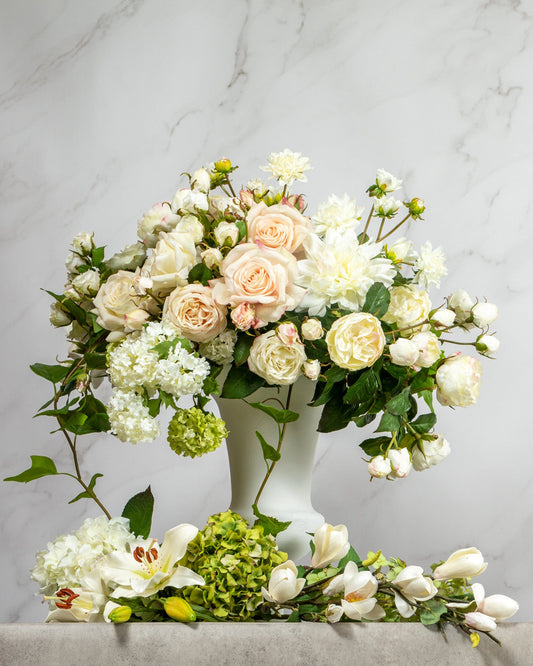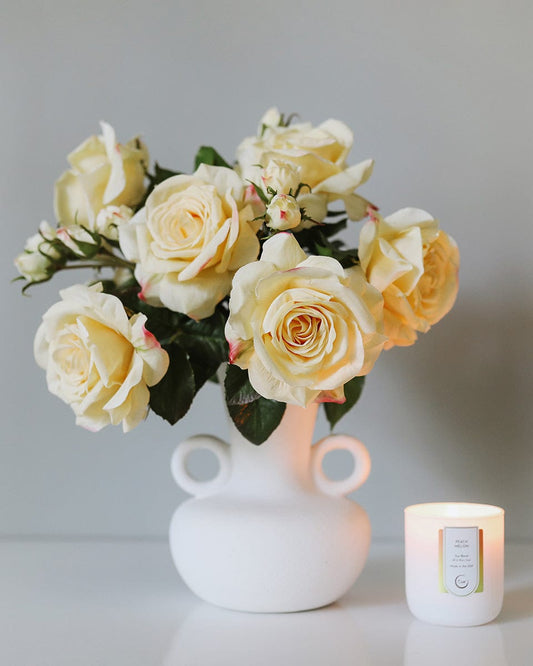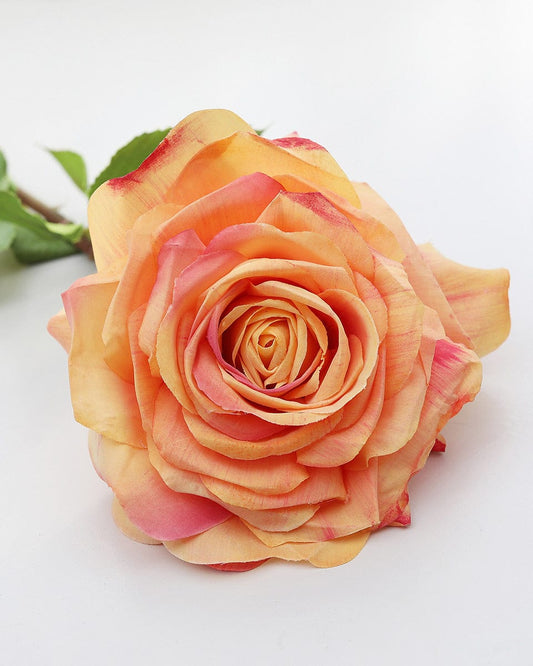Realistic Artificial Roses: How to Choose Flowers That Fool Everyone

I’m staring at a white rose on my desk right now, trying to figure out if the color is leaning cream or just picking up the warm lamplight. I keep second‑guessing it—yesterday it looked cooler. That little wobble is exactly how I decide if an artificial rose passes: it should make me hesitate. If I instantly think “plastic,” it’s out. If I have to walk around it, tilt my head, and check the shadow under the guard petals—okay, we’re in business.
Key Takeaways
- Realism lives in posture: vary heights and directions; bend at neck, mid, base.
- Control shine and light first; color is slippery and shifts under bulbs.
- Scale matters: big open faces for low bowls; tighter heads for tall vases.
- Mix a spray with a single hero bloom to fake variety fast.
Realism, oddly, shows up in the places that aren’t perfect. Petal edges that aren’t ruler‑straight. A head that doesn’t sit bolt upright. Leaves that aren’t mirror twins. Once you notice those cues, you can pick the good ones from ten feet away. Or be fooled up close, which is the actual goal.
Petal Surfaces That Don’t Scream “Plastic”
Petal surface first, because it’s the deal‑breaker. The expensive ones aren’t always better, by the way—that’s my slightly unpopular opinion. I’ve had mid‑priced stems read more convincing than the fancy ones, especially in harsh morning light. If a petal catches glare like a vinyl booth, I dust with the tiniest bit of cornstarch, blow off the excess, and it knocks the shine down without turning things chalky. If that still looks plastic, I pass.
I was fiddling with a cluster stem yesterday specifically to test glare and realized open faces take light differently than tighter buds. That sent me down the rabbit hole on how clusters cheat the “varying stages” look without you doing extra work. I wanted a quick proof, so I grabbed a white spray from my test bundle and bent two side shoots forward to give it that “reaching for light” posture.


White Artificial Rose Spray 23”
I bent two side shoots forward and one back; the wire held without that springy recoil, and the heads didn’t all stare in the same direction. Looked like a plant chasing a window.
That little posture tweak is 80% of realism. If the wire fights you or snaps back, the stem will read fake no matter how nice the petals are. Heads at slightly different heights trick the eye, fast. If you want a jumping‑off point to compare sprays, I keep a tab open to artificial roses because it’s easier to scan head sizes there while I’m messing with stems.
Light, Color, and Why Whites Lie
Colour trips me up constantly. Whites pick up wall paint; pinks go bubblegum under cool LEDs. I keep one blush stem on my desk to sanity‑check lighting because my ceiling bulbs are slightly too cool and keep lying to me. The weird part is how quickly the same flower changes from 10 a.m. to 8 p.m.
I had the blush open rose out for a vase test and noticed the tone reads soft in daylight but gets a little louder at night. That pushed me to compare it to a multi‑head pink spray for balance. Grabbing a single hero bloom and a cluster is my fast way to see how color and scale play in the same vase.


Real Touch Prestige Pink Rose 22”
Daylight reads blush; under my cool bulbs it shifts brighter. I tuck it near something cream to calm it down at night.
Once you notice that shift, you can use it. Pair a louder pink with a cream white to balance. Or rotate the pink to face away from the brightest bulb—light angle changes everything. If you’re scanning options, here’s the page I jump to for quick comparisons: realistic artificial roses.
If a leaf is too shiny, tap a tiny bit of cornstarch on the top surfaces only, then blow across it. Do not brush. Brushing can streak and you’ll chase that mark for an hour.
Stems, Wire Gauge, and the Bendy Reality Check
Stems and wire gauge, the unglamorous bit. If the stem has a plastic straw that squeaks when you bend it, pass. If you can bend at three points—neck, mid, and base—without the head twisting off‑axis, that’s good. Leaves shouldn’t sit in one perfect plane. I flick a couple down and leave one slightly crooked. It looks wrong in the hand. In a vase, it looks right.
I was testing head size for a coffee table bowl and needed something wider and softer in tone than bright white. I pulled a cream‑white open rose and tried it low in a squat vase—thought it might look like a golf ball plopped in a bowl, honestly.


Artificial White Ecuadorian Rose 23"
Dropped it low in a belly bowl and the open face filled space without looking like a golf ball. The cream reads softer than true white.
That test reminded me to watch scale. Small vase, larger open faces. Tall vase, mix tighter heads with one open bloom near the lip. It feels counterintuitive until you see it. Also—flip stems upside down. If the calyx looks like a melted bead, hard pass. If there’s a believable collar and a little texture, keep going.
How To Arrange So They Actually Fool People
Don’t be afraid of colour that isn’t wedding‑white. A touch of yellow or tangerine can look surprisingly natural in summer rooms. I used to avoid orange entirely—too loud. Then I tried one stem just to see if it would fight the oak table tone or settle in.
I grabbed a tangerine tea rose spray and tucked it into a neutral ceramic to see if it would clash. I expected chaos.


Faux Tangerine Tea Roses 20"
One stem warmed the whole vignette without shouting. I faced the brightest head away from the window and it calmed right down.
Turns out the warmer notes tie in with wood and brass. It reads vintage rather than neon. So yes, use colour, just control the direction of the bloom and the amount. Two stems might be plenty. And slightly underfill your vase—negative space around roses weirdly makes them look more expensive. Crammed heads look like grocery bundles.
Sometimes pre‑made pieces help with proportions. I don’t rely on them, but they’re handy when your brain is tired and you just need the “oh that scale works” confirmation. I stuck a compact white arrangement on a sideboard to check bowl height versus flower diameter, then copied the bloom‑to‑bowl ratio with loose stems.


Faux White Rose Centerpiece 11.5"
Helpful for eyeballing proportions on a shelf. I copied the bloom‑to‑bowl ratio with loose stems and it worked.
A few practical checks I run on every stem:
- Flip it upside down. If the calyx and receptacle look like a melted bead, hard pass. If there’s a believable collar and a bit of texture, keep going.
- Look at the underside of leaves. Flat green backs feel toyish. A gray‑green cast reads plant.
- Rotate the head. If it only wants to face straight ahead, twist the neck joint a hair to break that soldier stance.
- Mix in one bud or a half‑open head; identical faces are telltale.
If you want to browse what I’m poking at, start here: artificial roses. I’ll search with anchors like realistic artificial roses, best faux roses, fake white roses, and real touch roses. Those get me to the helpful filters fast. And if you’re deciding vase shapes, I’ve saved a note on picking heights so open faces don’t crowd the lip—helps a lot with scale.
Slightly underfill your vase. Negative space around roses looks intentional and expensive. Let a few leaves break the rim, not every head.
Frequently Asked Questions
How can you tell if artificial roses are good quality?
High-quality artificial roses have several key indicators: natural color variations with subtle gradients, flexible wire stems that hold their shape, detailed petal textures that aren't uniformly smooth, realistic calyx and receptacle details (not melted-looking plastic), multiple bloom stages in arrangements, and leaves with visible veining and slight color variations. The best roses also have a slight weight to them and don't look overly shiny under direct light.
How do I make my artificial roses look more realistic?
To make artificial roses look realistic: 1) Bend stems at multiple points for natural curves, 2) Vary the height and direction of each bloom, 3) Gently separate and fluff petals with your fingers, 4) Add a tiny amount of cornstarch to overly shiny petals, 5) Mix bloom stages (buds, half-open, full blooms), 6) Add water to clear vases, 7) Incorporate real greenery or branches, and 8) Face blooms away from direct light sources to minimize shine.
Can you mix artificial roses with real flowers?
Absolutely! Mixing artificial roses with fresh flowers creates stunning, long-lasting arrangements. Use artificial roses as your base flowers since they maintain their shape, then add fresh greenery, baby's breath, or seasonal accents. This technique is perfect for events where you need flowers to look perfect all day. The artificial roses provide structure while fresh elements add natural movement and fragrance.
The Final Test: Trust Your Hesitation
So here's the thing—I'm still staring at that white rose on my desk, and I'm still not entirely sure if it's cream or just catching the lamplight. And that's exactly the point. The best artificial roses make you pause, make you question, make you walk around them one more time. They don't announce themselves as fake from across the room.
Remember: perfection reads plastic. It's the slightly crooked leaf, the head that won't sit quite straight, the petal edge that catches light just a little differently—those are your tells that something might actually fool someone. Start with one good stem, learn its quirks in different lights, then build from there.
🌹 The Beauty That Never Fades
Our faux roses capture the very essence of nature. Come and explore our best selling collection!
Shop Artificial Roses Now









